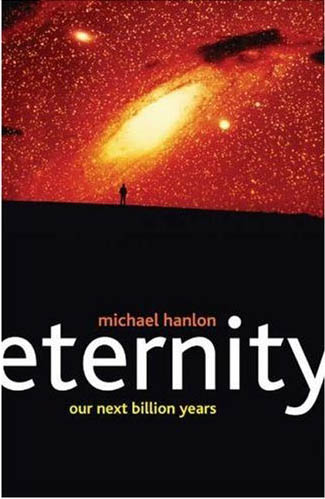 After passing the mental block of the second millennium, those of us who use the Gregorian calendar are suffering a bit of vertigo. For so long our future had a tangible ending point, now the future looks vast, overwhelming and not a little terrifying.
After passing the mental block of the second millennium, those of us who use the Gregorian calendar are suffering a bit of vertigo. For so long our future had a tangible ending point, now the future looks vast, overwhelming and not a little terrifying.
For so long thinking about the future meant thinking, literally, about tomorrow. During my childhood, in the 1970s, even the 1990s seemed almost impossibly distant - far more so than the 2020s do today. Those three little zeroes of the Millennium were a barrier, a symbol of a new dawn or a new nightmare, perhaps. Now we are through them, more or less safely, and the millennial comfort zone has vanished. Never before has the future seemed so vast and unknowable.
In writing Eternity I wanted to explore the possibilities of the distant future, the countless eons that lie ahead that are usually the sole preserve of the sci-fi writers (and when it comes to the truly far tomorrow, not that many even of them). Now that old, rather predictable future - the future of monorails and flying cars, of Year 2000 shiny jumpsuits and improbable architecture - is safely behind us, what can we say of that impossibly vast ocean of time that looms?
Well, for a start I take the unfashionable view that, whatever happens, the chances are that we do at least have a future. It has become received wisdom that our civilization (definitely), our species (probably) and even our planet itself (possibly) are doomed, and in fairly short order. While I in no way believe that the decades and centuries ahead will be a rose garden, it is easy to refute much of this modish catastrophism.
Humans are a hardy species, having survived several ice ages and at least one supervolcanic eruption (in Indonesia about 75,000 years ago), and despite primitive technology and the harsh brutalities of prehistoric life enough of our ancestors survived to spawn the current hordes. Now we have new things to worry about. Nuclear war remains the most potent existential threat. And there is a new kid on the disaster block: the threat posed by climate change has been equated by some to that from atomic Armageddon.
But again it seems unlikely that even these catastrophes would be the end of the world, in the truest sense of the word. Even an all-out nuclear exchange in the 1970s would have left billions of survivors. All species face extinction eventually, say the biologists, but the rules probably do not apply to an animal in possession of both nuclear weapons and antibiotics.
In fact, barring some spectacular catastrophe, it is probable that the greatest threats to the largest numbers of people in the coming couple of centuries come from climate change, the population explosion, disease and continuing misgovernance in Africa, dwindling natural resources and the psychological blows that will accompany the destruction of so many natural environments. If you want to see a post-apocalyptic world, where the masses do not have enough to eat, where violence stalks the land and everyone lives in fear and dreams of a civilised past, you do not have to see a disaster flick, just go to Zimbabwe or Darfur.
That's the bad news. The good is that the future contains almost limitless possibilities. I am (an unwilling) sceptic about space travel, but given enough time something resembling the techno-future of Arthur C Clarke may emerge. Our civilisation may have already sown the seeds of its own immortality; by simply pondering the ages to come we are doing what few have done before. Indeed, it is not impossible that the emergence of a technological civilisation that had its roots in the 18th century British Industrial Revolution will turn out to have a profound impact far beyond the confines of our world.
There may of course be trouble ahead. Some are already thinking about creating very long-term time capsules, such as the seedbank that has been established in Svalbard. We might want to think quite carefully what sort of knowledge we would want to pass on to a successor civilisation maybe 100,000 years hence; giving the Romans the atom bomb would have been disastrous. It may be equally bad to deliberately bequeath our technology to some future iron-age society.
Humans have been around for more than 100,000 years; pondering even this far ahead is mind-boggling enough. Thinking of a million years, enough time to swallow the rise and fall of a hundred Romes, is almost beyond our comprehension. But, come what may, this future is hurtling towards us, at an unstoppable second-per-second. The old future - our today - has not turned out to be as we imagined even 30 years ago, and no doubt our future will be equally strange and disconcerting. Maybe the flying cars, robots and jetpacks will finally arrive. Or maybe something even stranger and more exciting will come along to delight and bemuse our descendents in years to come.
Michael Hanlon's Eternity: Our Next Billion Years is published by Macmillan, priced £15.99.

